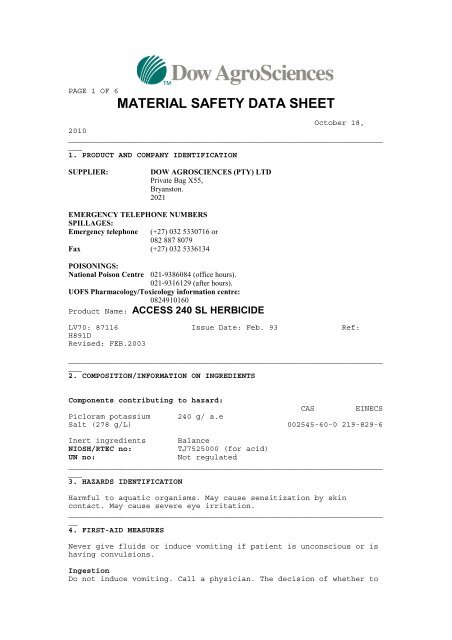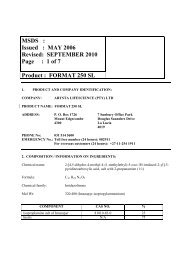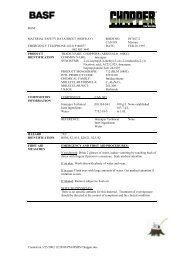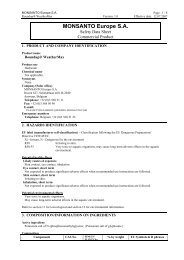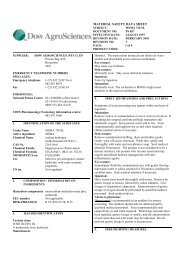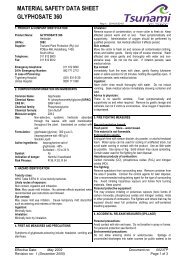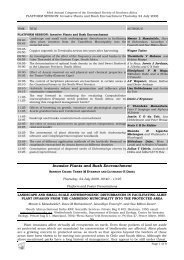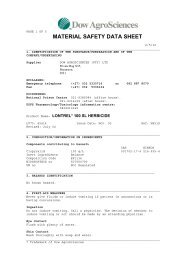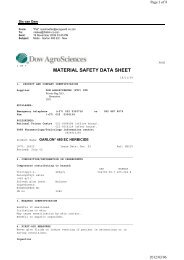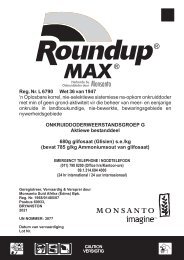MSDS Access 240 SL.rtf - Bush Encroachment
MSDS Access 240 SL.rtf - Bush Encroachment
MSDS Access 240 SL.rtf - Bush Encroachment
Create successful ePaper yourself
Turn your PDF publications into a flip-book with our unique Google optimized e-Paper software.
PAGE 1 OF 6<br />
MATERIAL SAFETY DATA SHEET<br />
October 18,<br />
2010<br />
_____________________________________________________________________<br />
___<br />
1. PRODUCT AND COMPANY IDENTIFICATION<br />
SUPPLIER:<br />
DOW AGROSCIENCES (PTY) LTD<br />
Private Bag X55,<br />
Bryanston.<br />
2021<br />
EMERGENCY TELEPHONE NUMBERS<br />
SPILLAGES:<br />
Emergency telephone (+27) 032 5330716 or<br />
082 887 8079<br />
Fax (+27) 032 5336134<br />
POISONINGS:<br />
National Poison Centre<br />
021-9386084 (office hours).<br />
021-9316129 (after hours).<br />
UOFS Pharmacology/Toxicology information centre:<br />
0824910160<br />
Product Name: ACCESS <strong>240</strong> <strong>SL</strong> HERBICIDE<br />
LV70: 87116 Issue Date: Feb. 93 Ref:<br />
H891D<br />
Revised: FEB.2003<br />
_____________________________________________________________________<br />
___<br />
2. COMPOSITION/INFORMATION ON INGREDIENTS<br />
Components contributing to hazard:<br />
CAS<br />
EINECS<br />
Picloram potassium <strong>240</strong> g/ a.e<br />
Salt (278 g/L) 002545-60-0 219-829-6<br />
Inert ingredients Balance<br />
NIOSH/RTEC no:<br />
TJ7525000 (for acid)<br />
UN no:<br />
Not regulated<br />
_____________________________________________________________________<br />
___<br />
3. HAZARDS IDENTIFICATION<br />
Harmful to aquatic organisms. May cause sensitization by skin<br />
contact. May cause severe eye irritation.<br />
_____________________________________________________________________<br />
__<br />
4. FIRST-AID MEASURES<br />
Never give fluids or induce vomiting if patient is unconscious or is<br />
having convulsions.<br />
Ingestion<br />
Do not induce vomiting. Call a physician. The decision of whether to
induce vomiting or not should be made by an attending physician.<br />
Eye Contact<br />
Irrigate immediately with water for at least 5 minutes. Consult a<br />
physician if irritation persists.<br />
_____________________________________________________________________<br />
___<br />
* Trademark of Dow AgroSciences
PAGE 2 OF 6<br />
MATERIAL SAFETY DATA SHEET<br />
18/10/10<br />
ACCESS* <strong>240</strong> <strong>SL</strong><br />
HERBICIDE<br />
_____________________________________________________________________<br />
___<br />
Skin Contact<br />
Immediately wash skin with soap and plenty of water. Remove<br />
contaminated clothing. Wash contaminated clothing before reuse.<br />
Inhalation<br />
Remove to fresh air. Consult a physician.<br />
Note to Physician<br />
Supportive care. Treatment based on judgement of physician in<br />
response<br />
to symptoms of patient.<br />
_____________________________________________________________________<br />
___<br />
5. FIRE-FIGHTING MEASURES<br />
Extinguishing Media<br />
Water fog or fine spray. Carbon dioxide. Dry chemical. Foam.<br />
Hazardous Combustion Products<br />
During a fire, smoke may contain the original material in addition to<br />
unidentified toxic and/or irritating compounds.<br />
Protection of Firefighters<br />
Wear protective clothing and use self-contained breathing apparatus.<br />
Additional Information<br />
Keep containers cool by spraying with water. Contain runoff to<br />
prevent<br />
entry into water or drainage systems.<br />
_____________________________________________________________________<br />
___<br />
6. ACCIDENTAL RELEASE MEASURES<br />
Personal Precautions<br />
Wear appropriate safety clothing and eye/face protection (see Section<br />
8). Prevent skin contact.<br />
Environmental Precautions<br />
Do not wash into sewers or into any body of water. Advise water<br />
authority if spillage has entered water course or drainage system.<br />
Methods of Cleaning Up<br />
Soak up with sand or other non-combustible absorbent material and<br />
place<br />
into containers for disposal. For large spills, barricade area and<br />
consult manufacturer. If further assistance is required, telephone<br />
the<br />
emergency contact number.
PAGE 3 OF 6<br />
MATERIAL SAFETY DATA SHEET<br />
HERBICIDE<br />
ACCESS* <strong>240</strong> <strong>SL</strong><br />
18/10/10<br />
______________________________________________________________<br />
_________<br />
7. HANDLING AND STORAGE<br />
Handling<br />
Use good personal hygiene. Do not consume or store food in the work<br />
area. Wash hands and exposed skin before eating, drinking or smoking<br />
and after work. Avoid skin contact. Remove contaminated clothing<br />
immediately and wash skin area with plenty of water.<br />
Storage<br />
Product should be stored in compliance with local regulations.<br />
Store in a cool, dry, well-ventilated place in the original<br />
container.<br />
Protect from excessive heat and cold. Do not store near food, drink,<br />
animal feeding stuffs, pharmaceuticals, cosmetics or fertilisers.<br />
Keep<br />
out of reach of children.<br />
_____________________________________________________________________<br />
___<br />
8. EXPOSURE CONTROLS/PERSONAL PROTECTION<br />
Exposure Guidelines<br />
Picloram: ACGIH Threshold Limit Value (TLV) is 10 mg/m3 TWA-8 hours.<br />
Engineering Controls<br />
Good general ventilation should be sufficient for most conditions.<br />
Local exhaust ventilation may be necessary for some operations.<br />
Respiratory Protection<br />
When airborne exposure guidelines and/or comfort levels may be<br />
exceeded,<br />
use an approved air-purifying respirator.<br />
For emergency conditions, use an approved positive-pressure selfcontained<br />
breathing apparatus.<br />
Hand/Skin Protection<br />
For brief contact, no precautions other than clean body-covering<br />
clothing and chemical resistant gloves should be needed.<br />
For emergency conditions: Use protective clothing impervious to this<br />
material. Selection of specific items will depend on operation.<br />
Eye/Face Protection<br />
Use safety glasses. Where contact with the liquid is likely, chemical<br />
goggles are recommended.
PAGE 4 OF 6<br />
MATERIAL SAFETY DATA SHEET<br />
ACCESS* <strong>240</strong> <strong>SL</strong> HERBICIDE<br />
18/10/10<br />
_____________________________________________________________________<br />
___<br />
9. PHYSICAL AND CHEMICAL PROPERTIES<br />
Appearance<br />
: liquid<br />
Colour<br />
: dark brown<br />
Rel. density (water=1)<br />
: 1.148 g/cm3 (approx.)<br />
Boiling point/range<br />
: 100 deg.C (approx.)<br />
pH : 9.0-11.2<br />
Vapour pressure<br />
: 22 mmHg/20 deg.C (approx.)<br />
Flash point<br />
: >100 deg.C (TCC)<br />
Water solubility<br />
: miscible<br />
_____________________________________________________________________<br />
___<br />
10. STABILITY AND REACTIVITY<br />
Chemical Stability<br />
Is stable under normal storage conditions.<br />
Conditions to Avoid<br />
Avoid extremes of temperature.<br />
Materials to Avoid<br />
Strong basic, acidic or oxidising materials.<br />
Hazardous Decomposition Products<br />
None under normal conditions of storage and use.<br />
_____________________________________________________________________<br />
___<br />
11. TOXICOLOGICAL INFORMATION<br />
Ingestion<br />
Single dose oral toxicity is considered to be low.<br />
The oral LD50 for rats is >5000 mg/kg.<br />
Skin Contact<br />
The dermal LD50 for rabbits is >5000 mg/kg.<br />
A single prolonged exposure is not likely to result in the material<br />
being absorbed through skin in harmful amounts.<br />
Prolonged or repeated exposure may cause slight skin irritation.<br />
Sensitisation<br />
Sensitising to guinea pig skin.<br />
Eye Contact<br />
May cause severe eye irritation. Corneal injury is unlikely. Effects<br />
likely to heal readily.<br />
Inhalation<br />
No adverse effects anticipated by this route of exposure incidental
to<br />
proper handling. The LC 50 for rats for 4 hours is >8.11 mg/L.
PAGE 5 OF 6<br />
MATERIAL SAFETY DATA SHEET<br />
18/10/10<br />
ACCESS* <strong>240</strong> <strong>SL</strong><br />
HERBICIDE<br />
_____________________________________________________________________<br />
___<br />
12. ECOLOGICAL INFORMATION<br />
Assessment largely or completely based on data for active ingredient.<br />
Persistence and Degradability<br />
The major route of degradation is by photolysis and photodegradation.<br />
Microbial degradation leads to formation of parent acid which<br />
undergoes<br />
further degradation. Half-life of the parent acid in soil is<br />
dependent<br />
on conditions and is approximately 10-278 days.<br />
Bio-concentration potential is low (BCF 10mg/kg of diet.<br />
Dietary LC50 for bobwhite quail is >10mg/kg in the diet.<br />
Other Information<br />
Active ingredient:<br />
Material is practically non-toxic to bees on an acute basis.<br />
Grazing:<br />
Picloram has no significant grazing restrictions. Beef cattle can<br />
even be present in the pasture during treatment. For lactating dairy<br />
cows, allow 14 days after applying <strong>Access</strong> <strong>240</strong> <strong>SL</strong>. Picloram is rapidly<br />
excreted in unchanged form by the animal via urine. Delay<br />
transferring livestock from treated areas onto land seeded with a<br />
desirable broadleaf crop for seven days. Urine and manure may<br />
otherwise injure sensitive broadleaf plants.<br />
_____________________________________________________________________<br />
___<br />
13. DISPOSAL CONSIDERATIONS<br />
Do not contaminate ponds, waterways or ditches with chemical or used<br />
container. Wash out thoroughly. Container and washings must be<br />
disposed<br />
of safely and in accordance with applicable regulations. The<br />
preferred<br />
options are to send to licensed reclaimer or to permitted<br />
incinerators.
Do not re-use container for any purpose.<br />
_____________________________________________________________________<br />
___<br />
14. TRANSPORT INFORMATION<br />
Sample shipment not allowed by mail. Product is not classified for<br />
any<br />
mode of transportation.<br />
_____________________________________________________________________<br />
___<br />
15. REGULATORY INFORMATION<br />
Hazard Symbol :<br />
Risk Phrases :<br />
Xi - Irritant<br />
May cause sensitisation by skin contact. (R43)<br />
Irritating to eyes.(R36)
PAGE 6 OF 6<br />
MATERIAL SAFETY DATA SHEET<br />
18/10/10<br />
HERBICIDE<br />
ACCESS* <strong>240</strong> <strong>SL</strong><br />
_____________________________________________________________________<br />
___<br />
Safety Phrases : Keep out of reach of children. (S2)<br />
Keep away from food, drink and animal feeding<br />
stuffs.<br />
(S13)<br />
When using do not eat, drink or smoke. (S20/21)<br />
Avoid contact with skin. (S24)<br />
Wear suitable protective clothing, gloves and<br />
eye/face protection. (S36/37/39)<br />
National Legislation:<br />
In accordance with the South African National Road Traffic Act, 1996<br />
(Act 93 of 1996), the Fire Brigade act, 1987 (Act 99 of 1987) and the<br />
Occupational Health and Safety Act, 1993 (Act No. 85 of 1993).<br />
_____________________________________________________________________<br />
___<br />
16. OTHER INFORMATION<br />
_____________________________________________________________________<br />
___<br />
This Material Safety Data Sheet complies with basic South African and<br />
EU regulatory requirements for Safety Data Sheets on the date of<br />
publication, and is intended for translation and adaptation into<br />
European National<br />
documents. This document should NOT be relied upon for compliance<br />
with<br />
the laws and regulations of individual countries without the<br />
appropriate<br />
local translations and adaptations. It is your responsibility to<br />
ensure<br />
that any Safety Data Sheet taken or adapted from this system for<br />
re-distribution or use complies with all the laws and regulations<br />
which<br />
apply to any such use or re-distribution.


